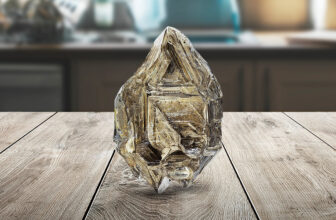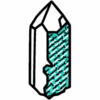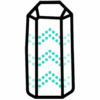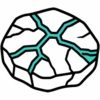Window Crystals
 What If a Crystal Could Offer a Clearer View?
What If a Crystal Could Offer a Clearer View?
Ever notice how moments of stress can make everything feel… blurry? As if you’re looking at your own life through a smudged pane of glass? Many people turn to meditation, journaling, or long walks to regain clarity. But what if a crystal could echo that same quiet shift — that small but meaningful moment when everything aligns, even for a heartbeat?
That’s where Window Formations step in, offering their quietly powerful presence.
These formations don’t shout. They whisper.
A Window Crystal is known for a distinctive extra face on its termination — usually a diamond or rhombus gently set between the main crystal facets. These windows may be perfectly clear or softly frosted, perfectly flat or slightly recessed. But no matter the appearance, they invite a very particular kind of attention: inward, steady, and honest.
Collectors often call them Portal Crystals or Seer Stones, names that hint at their long-held reputation as gateways to insight. And while the metaphysical world prizes them for reflection and truth, the scientific side has its own intrigue. Window faces are natural architectural quirks born from shifts in growth conditions — precise, delicate, and almost impossible to replicate artificially.
So when you peer into a Window Crystal, you’re not just looking at a geometric oddity. You’re looking at a physical record of change, pressure, and transformation — the same forces that shape people, just expressed in mineral form.
How Crystals Create Their Hidden Openings
Have you ever felt like subtle changes in your life stack up until, suddenly, you’re not quite the same person you were a month ago? Window Formations form in much the same way. Small shifts — nothing dramatic at first — eventually add up and change the shape of something solid.
During the final stages of crystallization, a crystal’s environment becomes a little unpredictable. Temperature may dip. Pressure might spike. Chemical ingredients drift in concentration. These tiny changes affect how fast each face of the crystal grows, and sometimes, one face slows just enough to create an extra geometric plane.
That plane becomes the window. Simple, subtle, and stunning.
Here’s the sequence:
- The crystal continues to form, building face upon face like a slow-motion architectural project.
- One face develops at a slightly different pace than the others. Not drastically — just enough.
- This imbalance carves out a rhombus- or diamond-shaped surface, a boundary where growth paused and then resumed.
- The final result? A small, intentional-looking window tucked into the termination.
These formations appear most often in Quartz varieties — Clear Quartz, Smoky Quartz, Amethyst — because quartz tends to grow in environments with fluctuating conditions. But you’ll occasionally find windows in Beryl, Fluorite, or even Calcite when the geological stage is just right.
What’s especially beautiful is that these windows aren’t fractures, damage, or inclusions. They’re growth modifications, like nature’s unexpected edits in the middle of a draft.
Think of it this way: a Window Formation is the crystal equivalent of that one life event that nudged you in a new direction — not enough to break you, but just enough to reshape you.
And like you, the crystal wears that moment with quiet elegance.
When You’re Searching for Answers
Ever find yourself staring at a problem so long that you start wishing for a lens that could help you see what you’ve been missing? Window crystals act a bit like that — physical reminders that sometimes we need a different angle, a new geometry, to understand what’s right in front of us. But first, you have to know what you’re looking at.
Window Formations have a very specific look, and once you learn the signs, they’re unmistakable.
The most defining feature is the diamond- or rhombus-shaped face set neatly between the crystal’s termination facets. This shape doesn’t feel accidental. It looks placed — balanced, centered, and often symmetrical. Some windows lie perfectly flush with the surface, shining like a polished pane. Others sink in just enough to create the illusion of depth, like a tiny doorway cut into stone. Still others have a soft, matte texture that diffuses light rather than reflecting it.
When you hold a crystal up to the light, these windows often catch illumination in ways that the other faces don’t. A clear window glints sharply. A frosted one holds the light like a breath. And an indented window casts the faintest shadow, adding that hint of mystery collectors love.
There are several variations you might encounter:
- Perfect Windows — bold, symmetrical diamonds that look intentionally carved.
- Subtle Windows — faint outlines or partially merged faces that hide in plain sight.
- Indented Windows — shallow recesses that pull your vision inward.
What matters most is balance. Natural window faces grow with smooth edges and harmonious symmetry. Damaged areas, by contrast, reveal rough textures and irregular lines — the telltale signs of breakage rather than formation.
Think of the difference like this:
A true window feels like a pause in the crystal’s growth — a moment of stillness captured in geometry. Damage feels like interruption.
When Perspective Feels Stuck
Ever catch yourself circling the same thoughts over and over, wishing for a fresh angle? Window Formations mirror that experience in their structure. Their variations — in placement, clarity, and shape — each offer a slightly different kind of “lens,” as if nature crafted multiple ways to see what we’ve been missing.
Window crystals aren’t one-note. Their diversity is part of their magic.
Different Orientations, Different Messages
Some windows sit right on the front face, perfectly positioned for meditation or simple contemplation. These crystals feel like an invitation to look inward — the kind of steady, grounding gaze that helps you sift through mental clutter.
Other windows appear along the sides, tucked into secondary faces. These often feel like reminders that shifting your position — even just a little — can uncover new understanding. They’re structural expressions of the phrase, “What if you tried looking at it this way?”
And then there are bottom windows, growing from the base or lower facets. These are rarer, and some people interpret them as openings into deeper memory or the foundation of personal experience. Whether or not you lean into metaphysics, they have a grounded, anchoring energy.
The Subtle Influence of Clarity
Not all windows shine the same way.
- Clear windows sparkle with transparency, offering crisp reflections and a sense of truth.
- Frosted windows soften the view, diffusing light like a dream just at the edge of waking.
- Reflective windows mirror more than they reveal, nudging you toward introspection.
Each clarity type has its own atmosphere, like shifting weather behind a pane of glass.
Geometry That Tells a Story
Most windows take the classic diamond shape, stable and balanced. But now and then you’ll find:
- Trapezoidal windows
- Irregular windows
- Distorted diamonds
These shapes often appear when the crystal experienced changes mid-growth — tiny disruptions that left their trace in stone. Their geometry feels alive, mid-transformation, almost like a snapshot taken during change rather than after it.
Mineral Personalities in Window Form
The mineral itself shapes the feeling of the window:
- Quartz windows sharpen clarity and amplify energy.
- Amethyst windows feel dreamy, intuitive, almost like a soft violet whisper.
- Smoky quartz windows bring depth and grounding, perfect for exploring the shadowy corners of thought.
Each mineral frames the window differently, like distinct types of picture frames surrounding the same central view.
What Window Crystals Can Teach About Clarity and Truth
Have you ever hit one of those days when your emotions feel tangled, loud, or strangely uncooperative? When you can sense something beneath the surface but can’t quite name it? Window crystals speak directly to that experience. Their entire identity centers on helping you see what’s usually hidden — gently, honestly, and without judgment.
At their core, Window Formations embody insight and self-examination. They’re the crystals people reach for when they’re ready to stop circling confusion and start understanding it. In metaphysical traditions, these windows function like tiny portals: openings through which awareness flows inward and outward. You look into the crystal’s window, and in some small way, the crystal invites you to do the same within yourself.
Many people describe working with a window crystal as sitting down with a very patient friend. No pressure. No theatrics. Just a steady, reflective presence that helps you make sense of your own thoughts.
Energetic Qualities That Support Reflection
Window crystals are often used to:
- Encourage deep meditation
- Reveal unconscious patterns or emotional blind spots
- Balance intuition with objectivity
- Strengthen quiet honesty within yourself
They aren’t about forcing breakthroughs. They’re about creating the space where breakthroughs can happen naturally — when you’re ready.
Meaning Hidden in Placement
The location of the window changes the kind of insight it’s believed to offer:
- Front-facing windows illuminate the present self — what’s happening now, what needs attention, what deserves compassion.
- Top windows point toward spiritual clarity or higher awareness, as if widening your internal sky.
- Base windows turn attention toward your roots, your past, and the emotional history you carry within you.
Each placement is like a different doorway into understanding.
Emotional Resonance
Window crystals resonate deeply with people navigating stress, confusion, or emotional shifts. They offer:
- Encouragement to tell yourself the truth (gently)
- Space to let illusions fall away
- A way to reconnect with your own authenticity
- A reminder that clarity doesn’t always arrive dramatically — sometimes it begins with a single, quiet moment
Personality by Mineral
The crystal’s mineral type adds another layer:
- Clear Quartz Windows: direct, illuminating clarity — the kind that feels like exhaling after holding in too much.
- Amethyst Windows: intuitive insight, dream clarity, and emotional calm.
- Smoky Quartz Windows: grounded reflection, steady release, and courage to acknowledge shadow aspects.
Window crystals teach a simple truth: when life gets noisy, clarity often arrives through stillness. And that small, shining face on the crystal — the window — becomes a reminder that understanding doesn’t need to be forced. It only needs room to appear.

 What If a Crystal Could Offer a Clearer View?
What If a Crystal Could Offer a Clearer View?



















